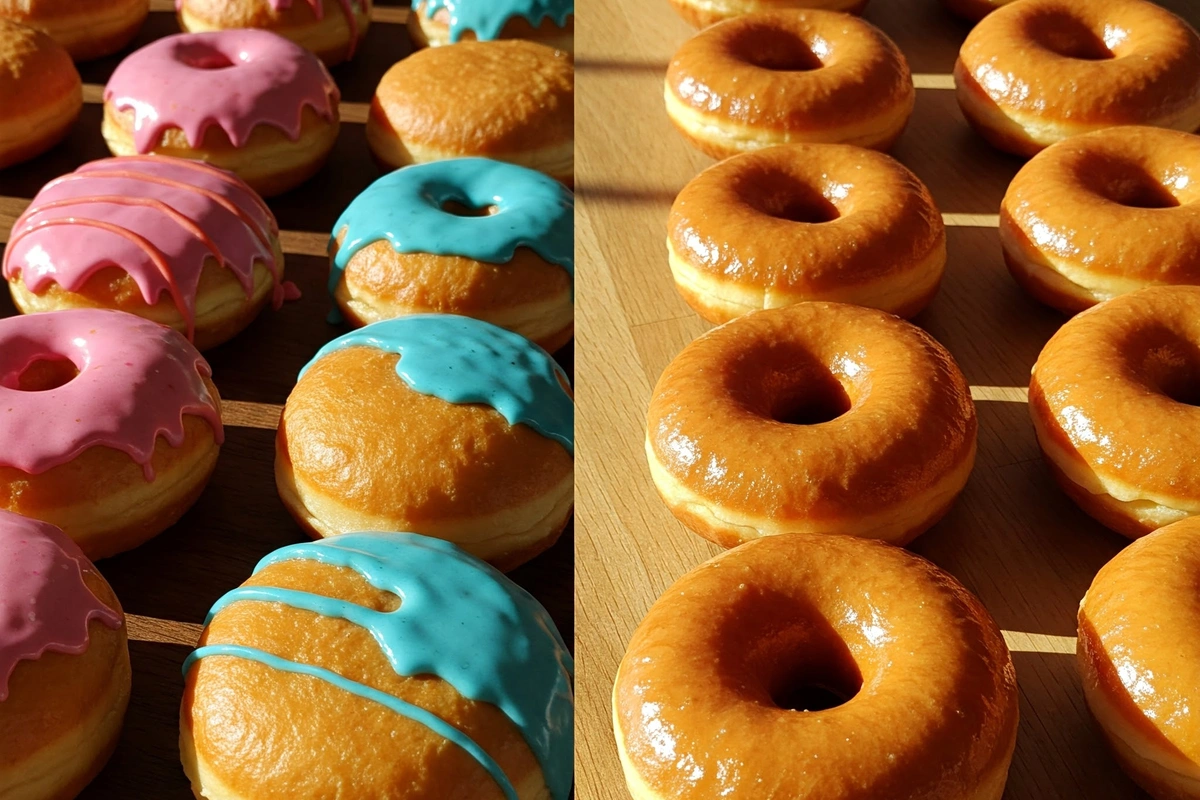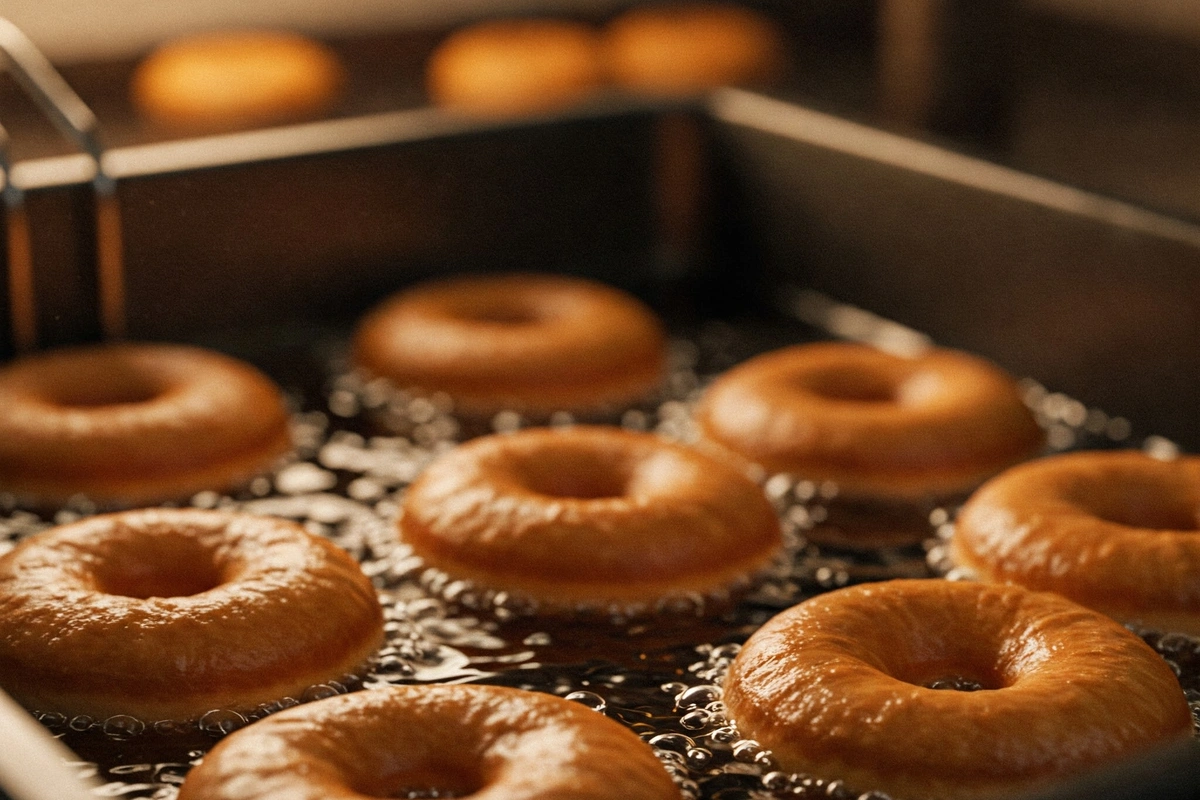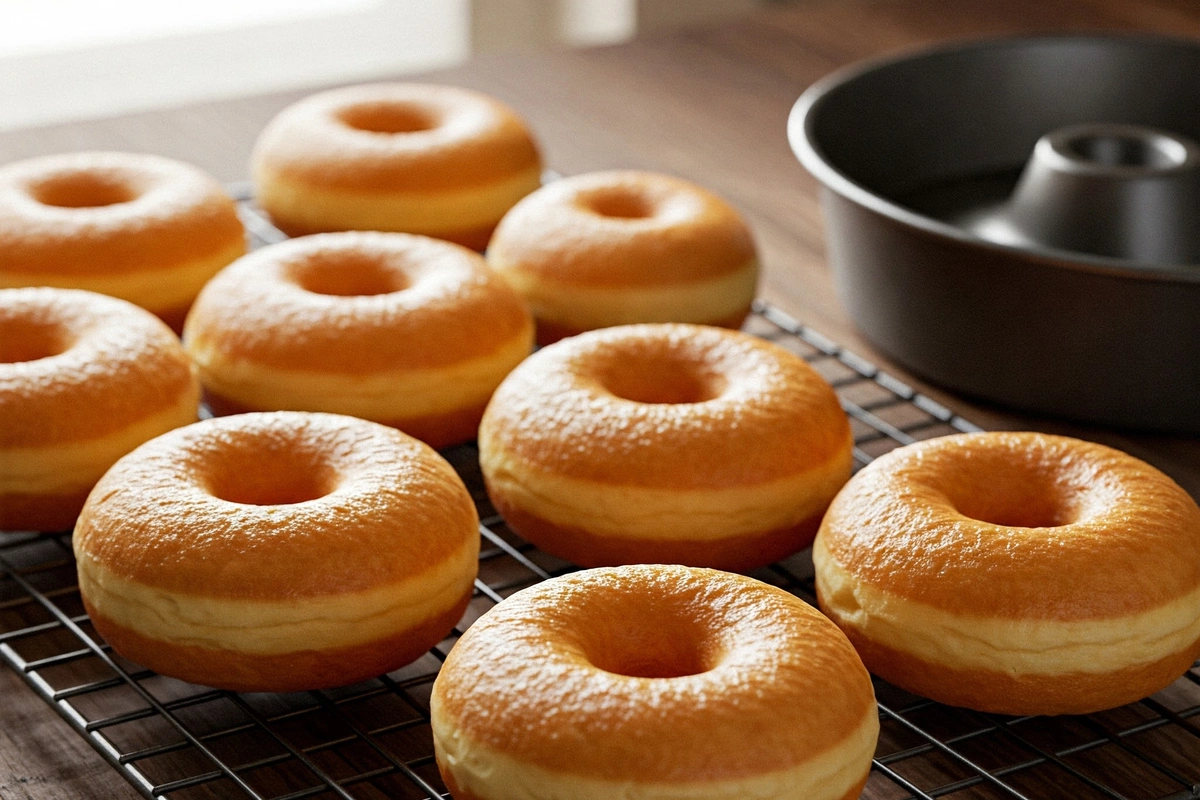When it comes to doughnuts, people often face an interesting dilemma: baking or frying? Both methods have their loyal fans and unique benefits. Some swear by the crispy, rich flavor of fried doughnuts, while others enjoy the healthier, mess-free convenience of baked ones. In this article, we’ll explore every angle of the question, “Is it better to bake or fry doughnuts?” We’ll cover taste, texture, nutrition, time, safety, and expert advice to help you choose the method that best suits your needs.
Let’s start by understanding each process and what makes them special.
Introduction to Doughnut Preparation
Overview of Doughnuts in Culinary Traditions
Doughnuts have been a beloved treat for centuries. Their origins trace back to various cultures, each with its take on deep-fried dough delicacies. From Dutch olykoeks to French beignets, doughnuts have evolved into the iconic sweet circles we love today. But, tradition aside, how they’re made matters a lot to the end result.
Importance of Choosing Between Baking and Frying
While frying is the classic method, modern health trends have driven the popularity of baked doughnuts. But does one method truly offer better results than the other? Some argue frying creates superior taste and texture, while others favor baking for being a cleaner, healthier option. The decision isn’t just about health—it impacts the final flavor, crunch, and even cooking time.
Brief Introduction to Pros and Cons of Each Method
Frying provides that iconic golden-brown, slightly crisp exterior with a soft, fluffy inside. However, it’s messy, requires a lot of oil, and adds more calories. On the other hand, baking is simpler and less time-consuming, but it can result in a drier, denser texture unless you perfect the recipe.
Now that you know what’s at stake, let’s dive into the details of each method to help you decide which one suits your style. Ready? Let’s explore frying first!
Traditional Frying Method for Doughnuts
Historical Roots of Fried Doughnuts
The origins of fried doughnuts go way back. In various parts of the world, deep-fried dough has long been a comfort food. The Dutch, for example, brought their famous olykoeks (oil cakes) to America, where they eventually evolved into the doughnuts we know today. Frying gives these treats their rich, golden color and perfectly crisp texture, which became an instant hit worldwide.
Process of Frying Doughnuts
Frying doughnuts isn’t as simple as tossing dough in oil. To get it just right, the oil needs to be heated to around 350°F (175°C). This ensures the outside becomes crisp without burning while the inside stays light and fluffy. Overheating the oil can lead to uneven cooking and a greasy mess—nobody wants that!
Advantages of Frying: Texture and Flavor
Let’s be honest: nothing beats the flavor of a fried doughnut. The oil enhances the dough’s richness, creating a slightly crunchy outer shell and a melt-in-your-mouth interior. This method also locks in moisture, making the doughnut feel airy and satisfying with each bite. It’s no wonder fried doughnuts are crowd-pleasers at fairs and bakeries.
Common Challenges of Frying
However, frying isn’t without its downsides. First, it’s messy. You’ve got hot oil splatters, greasy countertops, and the lingering smell of fried food. Additionally, frying can be tricky for beginners. Maintaining the perfect temperature takes practice, and there’s always the risk of undercooking or overcooking your doughnuts. Plus, let’s not forget the extra calories that come from all that oil.
Baked Doughnuts – A Modern Alternative
Emergence of Baked Doughnuts in Recent Years
Baked doughnuts rose in popularity as a healthier, easier-to-make option. With more people seeking guilt-free desserts, baking became the go-to method for those who wanted to indulge without feeling weighed down. From trendy cafes to home bakers, baked doughnuts have become a symbol of the “health-conscious cheat day.”
How Baked Doughnuts Are Made
The baking process couldn’t be more different from frying. Instead of dunking dough in hot oil, you simply place the dough in a doughnut mold or pan and bake it in the oven at around 350°F. This method eliminates the need for oil and cuts down on preparation time. It’s quick, clean, and perfect for batch baking.
Benefits of Baking: Convenience and Health Considerations
Baking doughnuts offers several key benefits. First, there’s minimal mess—no greasy pots to clean, no splattered stovetop. It’s also a safer process, especially if you’re baking with kids. Health-wise, baked doughnuts are lower in fat and calories since you’re skipping the frying oil. For many, this makes them a preferred option for breakfast or snack time.
Textural Differences Compared to Fried Doughnuts
That said, baked doughnuts have a different texture. They’re often described as lighter and fluffier, more like a cake than a classic doughnut. While some might prefer this texture, others may find them lacking the crispy exterior and depth of flavor found in fried versions. It ultimately boils down to personal preference and dietary goals.
Nutritional Comparison – Baked vs. Fried Doughnuts
Caloric Differences
One of the biggest factors in answering “Is it better to bake or fry doughnuts?” is calories. Fried doughnuts, because of the oil absorption, typically have a higher calorie count. Each fried doughnut can pack up to 300 calories or more, depending on the size and recipe. In contrast, baked doughnuts, with no frying oil involved, usually hover around 150–200 calories, making them a lighter option for those counting calories.
Impact of Frying Oils on Nutrition
Oil not only adds calories but also affects the overall fat content. Frying can significantly increase the levels of unhealthy fats, particularly if lower-quality oils are used or if the oil isn’t properly maintained. However, frying with oils high in healthy fats, such as avocado or peanut oil, can reduce the negative impact somewhat. On the other hand, baked doughnuts avoid this issue entirely by using minimal or no fat during cooking.
Fat and Sugar Content Variations
In general, fried doughnuts have a higher fat content, while both baked and fried varieties can contain similar amounts of sugar. The type of coating—like glazes or powdered sugar—can quickly add more calories and carbs. To keep sugar levels in check, some bakers opt for lighter toppings, especially for baked doughnuts.
Potential Health Benefits of Baked Doughnuts
For those with health-conscious goals, baked doughnuts offer clear advantages. They’re lower in fat and calories, and they can also be made using whole-grain flours or natural sweeteners. While they may not replicate the deep-fried flavor perfectly, they allow you to enjoy a doughnut without feeling like you’ve gone overboard.
Taste and Texture Differences
Comparing Crispiness and Chewiness
The texture is where the baked vs. fried doughnut debate really heats up. Fried doughnuts have a satisfying contrast between their slightly crisp exterior and tender, chewy interior. The frying process caramelizes the outside, giving each bite a richness that’s hard to replicate in the oven. Baked doughnuts, on the other hand, are more uniform in texture—soft and spongy throughout.
How Frying Enhances Dough Flavor
When dough is fried, the oil helps lock in flavor and moisture. This process creates subtle caramelized notes that give fried doughnuts their signature taste. Additionally, frying creates a golden-brown crust, adding complexity to the doughnut’s flavor profile. The same level of depth is rarely achieved with baking, which can sometimes leave the doughnut tasting more like a sweet bread or muffin.
Baked Doughnuts’ Lighter Texture
Baked doughnuts may not have the crispy exterior, but their texture appeals to those who prefer something lighter and less oily. Since they don’t rely on deep frying, they can feel less heavy on the stomach—perfect for a quick breakfast or post-workout snack. However, some people find the texture a bit too cake-like, especially if they expect a traditional doughnut experience.
Consumer Taste Preferences and Surveys
Consumer surveys often reveal a divide in preferences. Those who love rich, indulgent flavors tend to favor fried doughnuts, while health-conscious individuals gravitate towards baked options. Interestingly, many people who taste both side-by-side still choose fried doughnuts as their favorite. Ultimately, whether baked or fried is better comes down to personal taste and dietary goals.
Related Recipes
For more dessert inspiration, check out our apple doughnut recipe on Simita Recipes for another sweet treat idea. 🍩
Cooking Equipment Needed
Tools for Frying: Deep Fryer, Thermometer
When frying doughnuts, having the right equipment can make all the difference. A deep fryer is ideal because it maintains a consistent oil temperature, which is crucial for even cooking. If you don’t have a deep fryer, a large, heavy pot will work as long as you monitor the temperature carefully. This is where a kitchen thermometer comes in. Keeping the oil between 350°F and 375°F ensures that your doughnuts come out golden and crisp, not greasy or burnt.
Other helpful tools include a slotted spoon or wire skimmer for lifting doughnuts out of the oil, along with paper towels to drain excess grease. Without these essentials, frying can quickly become a messy and frustrating experience.
Tools for Baking: Doughnut Molds, Oven Settings
For baked doughnuts, your primary tool is a doughnut pan or silicone mold. These help create the classic ring shape while keeping the batter contained. An oven thermometer is also useful, as many ovens have inaccurate temperature gauges. Preheating your oven to 350°F is generally recommended, although this can vary by recipe.
Baking requires fewer tools overall and less cleanup. There’s no need for oil disposal or heavy-duty cleaning. This simplicity is one of the reasons many home cooks prefer baking to frying.
Cleaning and Maintenance Concerns
Frying leaves behind oil residue and a kitchen that smells like grease for hours. In contrast, baking requires minimal cleanup—just wash your pans and you’re done. If you prioritize convenience, baking might tip the scales when deciding “Is it better to bake or fry doughnuts?”
Comparing Time and Effort
Frying Time and Preparation Process
Frying doughnuts can be a time-consuming process. You need to heat the oil, which can take several minutes, and monitor the temperature throughout cooking. Each batch usually takes 2–3 minutes per side to fry, depending on the doughnut’s thickness. Since you can only fry a few at a time, it may take multiple batches to finish a full recipe.
Additionally, the cleanup effort is significant. You’ll have hot oil to dispose of safely and greasy cookware to scrub clean. Frying may deliver exceptional taste and texture, but it often demands both time and patience.
Baking Time and Preparation Ease
Baking, on the other hand, streamlines the entire process. Once you prepare the batter and fill the doughnut molds, you simply place them in the oven. Baking usually takes 10–12 minutes per batch, and since you can bake multiple pans at once, it’s much faster for large quantities.
There’s also minimal need for supervision—no worrying about oil temperature or flipping doughnuts mid-cook. This hands-off approach makes baking ideal for beginners or anyone short on time. Cleanup is easy, too. Just wash the pans and you’re done!
Which Method is Faster and More Efficient?
In most cases, baking is the faster and easier option. However, if you’re after that authentic fried doughnut experience, you might find the extra effort worth it. Ultimately, answering the question “Is it better to bake or fry doughnuts?” depends on how much time and effort you’re willing to invest.
Environmental and Safety Considerations
Risks of Frying with Hot Oil
Frying doughnuts may produce delicious results, but it comes with certain risks. Handling hot oil can be dangerous, especially for beginners. If the oil is overheated, it can catch fire or cause serious burns. Even at the right temperature, oil can splatter, potentially injuring anyone nearby. Keeping a fire extinguisher rated for grease fires is a good precaution when frying.
Oil disposal also presents a challenge. Pouring used oil down the drain can lead to clogs and plumbing issues. Instead, the oil needs to be cooled, strained, and properly discarded, which adds to the cleanup effort.
Energy Consumption: Baking vs. Frying
When it comes to energy efficiency, baking has an edge. Ovens consume energy to preheat and maintain a stable temperature, but this is relatively straightforward. Deep fryers or stovetops require constant temperature control, which can lead to spikes in energy use.
Additionally, baking generates less heat and odor in your kitchen, making it more comfortable for home cooking. Those factors may influence your decision in the ongoing debate of “Is it better to bake or fry doughnuts?”
Tips for a Safer Cooking Experience
Whether you bake or fry, safety should always come first. Use oven mitts, avoid overcrowding your workspace, and keep children at a safe distance. If frying, always monitor the oil and never leave it unattended. These small precautions can prevent accidents and make your doughnut-making experience more enjoyable.



